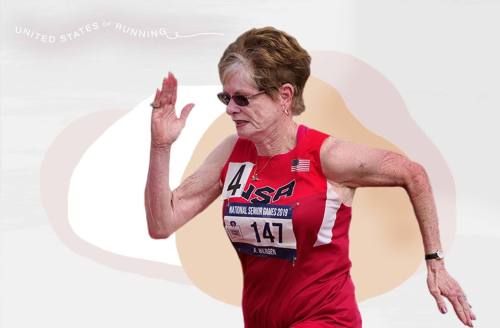I’m an 80-year-old runner and I’ve broken 17 World Records—this is how I train
We chat with Kathy Bergen, and octogenarian runner and track star, about her workout routine, what motivates her, and how she recovers sore muscles.

Even though I live in a small town, La Canada, near Pasadena in southern California, in the foothills of the mountains, I haven’t hiked since I was a Girl Scout. I would much rather run.
Growing up in Brooklyn, we played in the streets: hide and seek, tag, you name it. But I went to an all-girls high school, and the only available sports were intramural volleyball and basketball, which I played in my junior and senior years. Then, I went to Marymount Manhattan College in New York City, which had no sports whatsoever, so I was out of the game until I moved to California at 33. But, I’ve always been fast.
I didn’t actually get involved with track and field until I was 54 and my husband Bert was 56. We saw an article in AARP magazine about the senior Olympics, which were being held at a college near our home. We started training and at my first meet, I ran the 50-meter dash in 7.6 seconds and the 100-meter dash in 14.9 seconds. I was faster than all the other runners, which was amazing since I did a standing start. Using starting blocks is a much more efficient way to start, but I didn’t know how and I didn’t have access to them. Fast forward twenty-five years, and I still participate in the high jump, sprint, and throw the discus and javelin.
To date, I’ve broken 17 World Records. I broke my first in the 55 to 59-year-old age group (you participate within five-year age brackets), and I also broke the American record in the high jump in that age group. I broke a couple more in my 60s, but in my 70s I broke 12 world records and one American record in the discus.
It takes a lot of training. I work out three days a week doing track work, then after an hour or two of rest, I go to the local senior center in Pasadena to do some free weights, stretching, and flexibility exercises. I take off in between so I can properly rest. Since it’s off season, my workouts are toned down a bit. I always warm up for half an hour doing a slow jog, a faster jog, and 30 meters of an A-skip, B-skip, and high knees. Warming up is so important for me to run and not get injured. Then, the workout begins. Yesterday, my workout was two 200 meter dashes at 75 percent, and one 150 meter dash at 75 percent. In between those runs, I rest for about six or seven minutes. Most importantly, I only run on tracks, because they’re way better on the joints.
I’ve continuously trained the whole time, but I’ve definitely found myself in ruts. Ten years ago, when I was 69, I had two particularly sluggish years. Nothing too serious. When I started out, I was a good runner and so I’d train by doing something every day, like going to the gym, going to the track, and playing tennis, but I found myself stalling progress. At the end of my training year, I found a coach, Eric Dixon. I gave him a call, met with him, and he told me that everything I was doing was wrong. I wasn’t structuring proper workouts or resting between my runs—I was doing too much and not allowing my body to heal. In the years I’ve worked with him, I’ve become a world-class sprinter.
My birthday is Christmas Eve, so I’ll age up to the 80 to 84-year-old group as of 2020, and I can’t wait. I’ll be working harder, because next year I want to break six world records. When I move to a new age group, I break records. For me, I love the competition. I will do it until I can’t. It’s really exciting to be very good at something—better at it than most people my age. It’s something that keeps you going.
As told to Rachel Lapidos on September 27, 2019.
Feeling inspired? (Same.) Here’s our United States of Running 5K training program, along with a HIIT running workout that’ll pack a sweat in little time.
Sign Up for Our Daily Newsletter
Get all the latest in wellness, trends, food, fitness, beauty, and more delivered right to your inbox.
Got it, you've been added to our email list.










